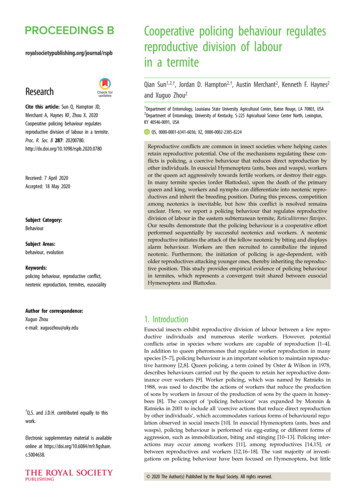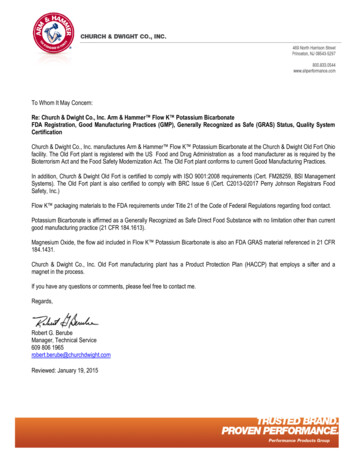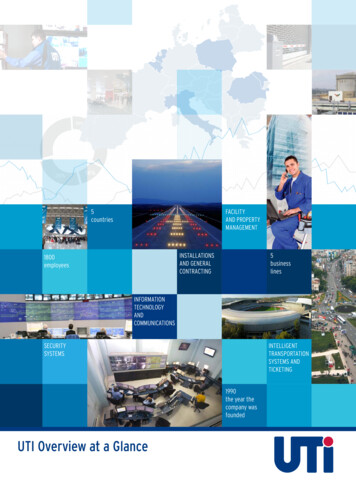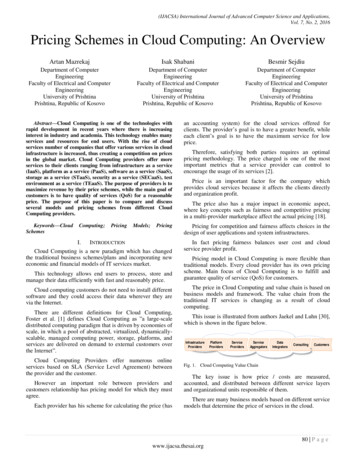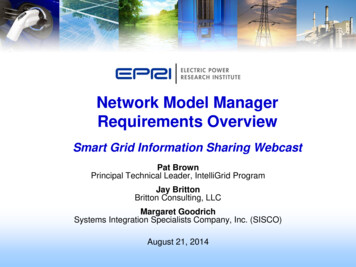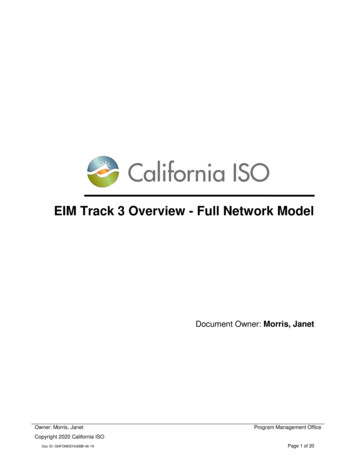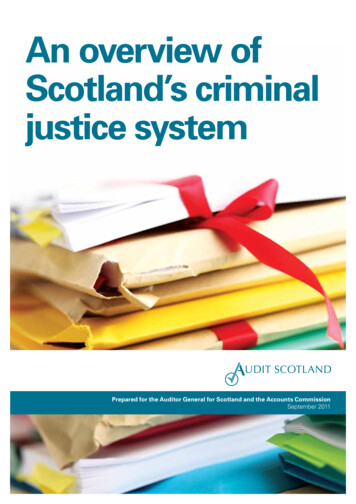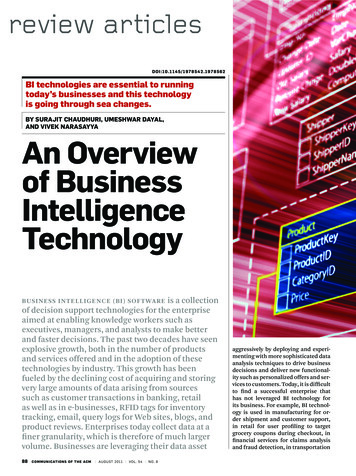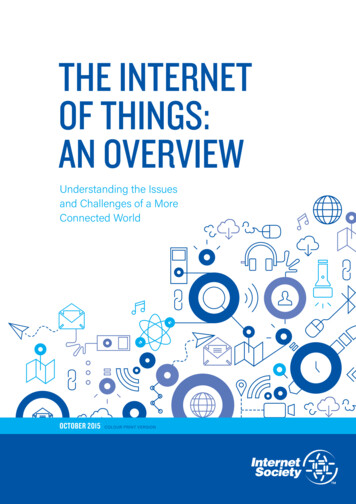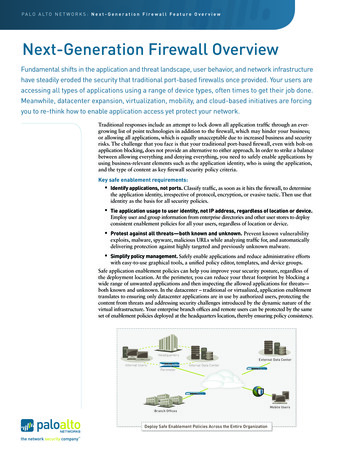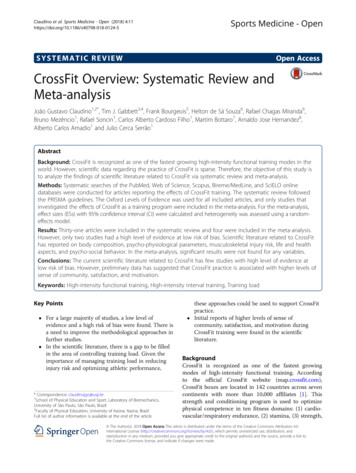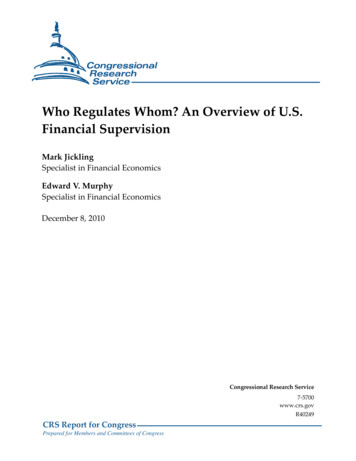
Transcription
Who Regulates Whom? An Overview of U.S.Financial SupervisionMark JicklingSpecialist in Financial EconomicsEdward V. MurphySpecialist in Financial EconomicsDecember 8, 2010Congressional Research Service7-5700www.crs.govR40249CRS Report for CongressPrepared for Members and Committees of Congress
Who Regulates Whom? An Overview of U.S. Financial SupervisionSummaryThis report provides an overview of current U.S. financial regulation: which agencies areresponsible for which institutions, activities, and markets, and what kinds of authority they have.Some agencies regulate particular types of institutions for risky behavior or conflicts of interest,some agencies promulgate rules for certain financial transactions no matter what kind ofinstitution engages in it, and other agencies enforce existing rules for some institutions, but notfor others. These regulatory activities are not necessarily mutually exclusive.There are three traditional components to U.S. banking regulation: safety and soundness, depositinsurance, and adequate capital. The Dodd-Frank Wall Street Reform and Consumer ProtectionAct (P.L. 111-203) added a fourth: systemic risk. Safety and soundness regulation dates back tothe 1860s when bank credit formed the money supply. Examinations of a bank’s safety andsoundness is believed to contribute to a more stable broader economy. Deposit insurance wasestablished in the 1930s to reduce the incentive of depositors to withdraw funds from banksduring a panic. Banks pay premiums to support the deposit insurance fund, but the Treasuryprovides full faith and credit for covered deposits if the fund were to run short. Deposit insuranceis a second reason that federal agencies regulate bank operations, including the amount of riskthey may incur. Capital adequacy has been regulated since the 1860s when “wildcat banks”sought to make extra profits by reducing their capital reserves, which increases their risk ofdefault and failure. Dodd-Frank created the interagency Financial Stability Oversight Council(FSOC) to monitor systemic risk and consolidated bank regulation from five agencies to four. Forbanks and non-banks designated by the FSOC as creating systemic risk, the Federal Reserve hasoversight authority, and the Federal Deposit Insurance Corporation (FDIC) has resolutionauthority.Federal securities regulation has traditionally been based on the principle of disclosure, ratherthan direct regulation. Firms that sell securities to the public must register with the Securities andExchange Commission (SEC), but the agency generally has no authority to prevent excessive risktaking. SEC registration in no way implies that an investment is safe, only that the risks havebeen fully disclosed. The SEC also registers several classes of securities market participants andfirms. It has enforcement powers for certain types of industry misstatements or omissions and forcertain types of conflicts of interest. Derivatives trading is supervised by the Commodity FuturesTrading Commission (CFTC), which oversees trading on the futures exchanges, which have selfregulatory responsibilities as well. Dodd-Frank has required more disclosures in the previouslyunregulated over-the-counter (off-exchange) derivatives market and has granted the CFTC andSEC authority over large derivatives traders.The Federal Housing Finance Agency (FHFA) oversees a group of government-sponsoredenterprises (GSEs)—public/private hybrid firms that seek both to earn profits and to further thepolicy objectives set out in their statutory charters. Two GSEs, Fannie Mae and Freddie Mac,were placed in conservatorship by the FHFA in September 2008 after losses in mortgage assetportfolios made them effectively insolvent.Dodd-Frank consolidated consumer protection rulemaking, which had been dispersed amongseveral federal agencies in a new Bureau of Consumer Financial Protection. The bureau isintended to bring consistent regulation to all consumer financial transactions, although thelegislation exempted several types of firms and transactions from its jurisdiction.Congressional Research Service
Who Regulates Whom? An Overview of U.S. Financial SupervisionContentsIntroduction .1What Financial Regulators Do.1Banking Regulation .6Safety and Soundness Regulation.6Deposit Insurance .7Capital Regulation .7Systemic Risk .8Capital Requirements .8Basel III .9Capital Provisions in Dodd-Frank . 10Non-Bank Capital Requirements . 12The SEC’s Net Capital Rule . 12CFTC Capital Requirements . 12Federal Housing Finance Agency . 13The Federal Financial Regulators . 14Banking Regulators. 14Office of the Comptroller of the Currency . 15Federal Deposit Insurance Corporation. 15The Federal Reserve. 16Office of Thrift Supervision (Abolished by Dodd-Frank). 17National Credit Union Administration . 18Non-Bank Financial Regulators. 18Securities and Exchange Commission . 18Commodity Futures Trading Commission . 21Federal Housing Finance Agency . 21Bureau of Consumer Financial Protection . 22Regulatory Umbrella Groups. 23Financial Stability Oversight Council . 23Federal Financial Institution Examinations Council. 24President’s Working Group on Financial Markets . 24Unregulated Markets and Institutions . 25Foreign Exchange Markets. 25U.S. Treasury Securities . 25Private Securities Markets. 26Comprehensive Reform Legislation in the 111th Congress . 26FiguresFigure A-1. National Bank . 28Figure A-2. National Bank and Subsidiaries . 28Figure A-3. Bank Holding Company . 29Figure A-4. Financial Holding Company . 29Congressional Research Service
Who Regulates Whom? An Overview of U.S. Financial SupervisionTablesTable 1.Federal Financial Regulators and Who They Supervise .4Table 2.The Basel Accords: Risk Weightings for Selected Financial Assets Under theStandardized Approach .9Table 3.Capital Standards for Federally Regulated Depository Institutions. 11AppendixesAppendix A. Forms of Banking Organizations. 28Appendix B. Bank Ratings: UFIRS and CAMELS . 30Appendix C. Acronyms . 32Appendix D. Regulatory Structure Before the Dodd-Frank Act. 33Appendix E. Glossary of Terms. 34ContactsAuthor Contact Information . 41Acknowledgments . 41Congressional Research Service
Who Regulates Whom? An Overview of U.S. Financial SupervisionIntroductionHistorically, major changes in financial regulation in the United States have often come inresponse to crisis. Thus, it is no surprise that the turmoil beginning in 2007 led to calls for reform.Few would argue that regulatory failure was solely to blame for the crisis, but it is widelyconsidered to have played a part. In February 2009, Treasury Secretary Timothy Geithnersummed up two key problem areas:Our financial system operated with large gaps in meaningful oversight, and withoutsufficient constraints to limit risk. Even institutions that were overseen by our complicated,overlapping system of multiple regulators put themselves in a position of extremevulnerability. These failures helped lay the foundation for the worst economic crisis ingenerations.1In this analysis, regulation failed to maintain financial stability at the systemic level because therewere gaps in regulatory jurisdiction and because even overlapping jurisdictions—whereinstitutions were subject to more than one regulator—could not ensure the soundness of regulatedfinancial firms. In particular, limits on risk-taking were insufficient, even where regulators hadexplicit authority to reduce risk.This report attempts to set out the basic principles underlying U.S. financial regulation and togive some historical context for the development of that system. The first section brieflydiscusses the various modes of financial regulation and includes a table identifying the majorfederal regulators and the types of institutions they supervise. The table also indicates certainemergency authorities available to the regulators, including those that relate to systemic financialdisturbances. The second section focuses on capital requirements—the principal means ofconstraining risky financial activity—and how risk standards are set by bank, securities, andfutures regulators.The next sections provide brief overviews of each federal financial regulatory agency anddiscussions of several major financial markets that are not subject to any federal regulation.What Financial Regulators DoThe regulatory missions of individual agencies vary, partly as a result of historical accident. Hereis a rough division of what agencies are called upon to do: Regulate Certain Types of Financial Institutions. Some firms become subjectto federal regulation when they obtain a particular business charter, and severalfederal agencies regulate only a single class of institution. Depository institutionsare a good example: a new banking firm chooses its regulator when it decideswhich charter to obtain—national bank, state bank, credit union, etc.—and thechoice of charter may not greatly affect the institution’s business mix. TheFederal Housing Finance Authority (FHFA) regulates only three governmentsponsored enterprises: Fannie Mae, Freddie Mac, and the Federal Home Loan1Remarks by Treasury Secretary Timothy Geithner Introducing the Financial Stability Plan, February 10, m.Congressional Research Service1
Who Regulates Whom? An Overview of U.S. Financial SupervisionBank system. Regulation keyed to particular institutions has at least twoperceived disadvantages: regulator shopping, or regulatory arbitrage, may occurif regulated entities can choose their regulator, and unchartered firms engaging inthe identical business activity as regulated firms may escape regulationaltogether. Regulate a Particular Market. The New York Stock Exchange dates from 1793,federal securities regulation from 1934. Thus, when the Securities and ExchangeCommission (SEC) was created by Congress, stock and bond market institutionsand mechanisms were already well-established, and federal regulation wasgrafted onto the existing structure. As the market evolved, however, Congressand the SEC faced numerous jurisdictional issues. For example, de minimisexemptions to regulation of mutual funds and investment advisers created spacefor the development of a trillion-dollar hedge fund industry, which wasunregulated until the Dodd-Frank Act.Market innovation also creates financial instruments and markets that fallbetween industry divisions. Congress and the courts have often been asked todecide whether a particular financial activity belongs in one agency’s jurisdictionor another’s. Regulate a Particular Financial Activity. When regulator shopping orperceived loopholes appear to weaken regulation, one response is to create aregulator tasked with overseeing a particular type or set of transactions,regardless of where the business occurs or which entities are engaged in it. In1974, Congress created the Commodity Futures Trading Commission (CFTC) atthe time when derivatives were poised to expand from their traditional base inagricultural commodities into contracts based on financial instruments andvariables. The CFTC was given “exclusive jurisdiction” over all contracts thatwere “in the character of” options or futures contracts, and such instruments wereto be traded only on CFTC-regulated exchanges. In practice, exclusivejurisdiction was impossible to enforce, as off-exchange derivatives contracts suchas swaps proliferated. In 2000, Congress exempted swaps from CFTC regulation,but this exemption was repealed by Dodd-Frank.On the view that consumer financial protections should apply uniformly to alltransactions, the Dodd-Frank Act created a Bureau of Consumer FinancialProtection, with authority (subject to certain exemptions) over an array of firmsthat deal with consumers. Regulate for Systemic Risk. One definition of systemic risk is that it occurswhen each firm manages risk rationally from its own perspective, but the sumtotal of those decisions produces systemic instability under certain conditions.Similarly, regulators charged with overseeing individual parts of the financialsystem may satisfy themselves that no threats to stability exist in their respectivesectors, but fail to detect systemic risk generated by unsuspected correlations andinteractions among the parts of the global system. The Federal Reserve was formany years a kind of default systemic regulator, expected to clean up after acrisis, but with limited authority to take ex ante preventive measures. DoddFrank creates the Financial Stability Oversight Council (FSOC) to assume acoordinating role, with the single mission of detecting systemic stress before aCongressional Research Service2
Who Regulates Whom? An Overview of U.S. Financial Supervisioncrisis can take hold (and identifying firms whose individual failure might triggercascading losses with system-wide consequences).From time to time, the perceived drawbacks to the multiplicity of federal regulators brings forthcalls for regulatory consolidation.2 The legislative debate over Dodd-Frank illustrates the differentviews on the topic: early versions of the Senate bill would have replaced all the existing bankregulators with a single Financial Institution Regulatory Authority. By the end, however, DoddFrank created two new agencies (and numerous regulatory offices), and eliminated only theOffice of Thrift Supervision (OTS).There have always been arguments against regulatory consolidation. Some believe that afragmentary structure encourages innovation and competition and fear that the “dead hand” of asingle financial supervisor would be costly and inefficient. Also, there is little evidence thatcountries with single regulators fare better during crises or are more successful at preventingthem. One of the first proposals by the Conservative government elected in the UK in May 2010was to break up the Financial Services Authority, which has jurisdiction over securities, banking,derivatives, and insurance.Table 1 below sets out the federal financial regulatory structure as it will exist once all theprovisions of the Dodd-Frank Act become effective. (In many cases, transition periods end a yearor 18 months after July 21, 2010, the date of enactment. Thus, OTS does not appear in Table 1,even though the agency will continue to operate into 2011.) Appendix D of this report contains apre-Dodd-Frank version of the same table. Supplemental material—charts that illustrate thedifferences between banks, bank holding companies, and financial holding companies—appearsin Appendix A.2See, e.g., U.S. Department of the Treasury, Blueprint for a Modern Financial Regulatory Structure, March 2008,which called for a three-agency structure: a systemic risk regulator, a markets supervisor, and a consumer regulator.Congressional Research Service3
Who Regulates Whom? An Overview of U.S. Financial SupervisionTable 1.Federal Financial Regulators and Who They SuperviseRegulatory AgencyFederal ReserveInstitutions RegulatedBank holding companiesaand certain subsidiaries,financial holdingcompanies, securitiesholding companies, savingsand loan holdingcompanies, and any firmdesignated as systemicallysignificant by the FSOCState banks that aremembers of the FederalReserve System, U.S.branches of foreign banks,and foreign branches ofU.S. banksPayment, clearing, andsettlement systemsdesignated as systemicallysignificant by the FSOC,unless regulated by SEC orCFTCEmergency/SystemicRisk PowersLender of last resort tomember banks (throughdiscount window lending)In “unusual and exigentcircumstances” the Fedmay extend credit beyondmember banks, for thepurpose of providingliquidity to the financialsystem, but not to aidfailing financial firmsMay initiate resolutionprocess to shut downfirms tha
the identical business activity as regulated firms may escape regulation altogether. Regulate a Particular Market. The New York Stock Exchange dates from 1793, federal securities regulation from 1934. Thus, when the Securities and Exchange Commission (SEC) wa
